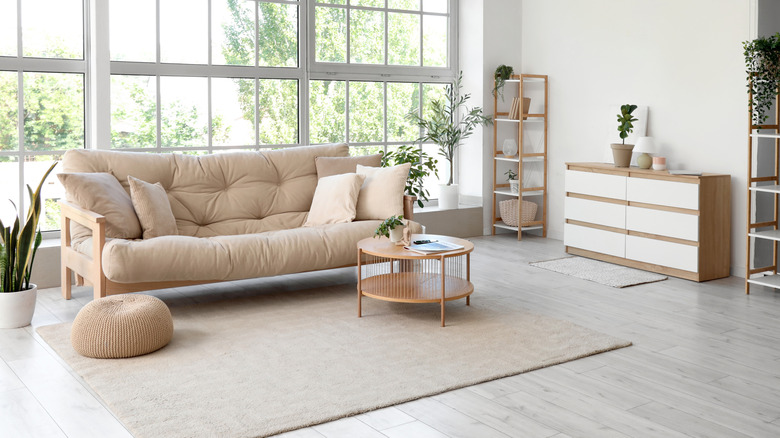The Gen Z Trend That's Horrible For Home Value
Open Instagram now, and chances are it won't take long before you see an image or two of homes washed in shades of beige. Cream sofas, off-white curtains, light wood furniture, and maybe a single indoor olive tree for a pop of "life." It's the aesthetic that's taken over Gen Z's design world — calm, curated, and filter-friendly. On social media, these spaces look immaculate. But while this trend may rack up likes, it's actually hurting home value in the real world.
This "Instagram beige" trend is essentially an evolution of the "Millennial gray" style, which itself is a reaction to the cluttered, overdecorated homes of the early 2000s. While Millennials wanted sleek and modern, Gen Z went for calm and organic.
And to be fair, there's nothing wrong with loving a clean, minimal look. The problem isn't the color but the commitment. Keep in mind that what looks good on your phone doesn't always hold up in a real-world living space. Beige may look cohesive online, but in person, it can feel flat and lifeless.
The irony is that this trend, which is all about timelessness, has quickly become a timestamp of its own. When every influencer's living room looks virtually the same, beige stops feeling timeless and starts feeling trendy — and not in a good way. Trends, as every homeowner eventually comes to realize, don't really help property value. A house that looks pretty on Instagram might not be the one that sells quickly. Just as reducing bedroom numbers is one home renovation that can diminish property value, dousing your house in beige can have the same effect.
Why Instagram beige kills resale value
The thing about beige minimalism is that it looks great online, but buyers shop in person. And in person, the reaction is often the same: "meh." Homes that are staged in all-neutral tones tend to look beautiful in photos but leave visitors underwhelmed during showings, whereas more dynamic tones like dusty green or muted blue create a sense of energy. All-beige interiors, however, can make rooms feel sterile and cold, especially under natural light.
And let's not forget about the practical side. Light fabrics and neutral furniture can be a nightmare to maintain, especially for families, pets, or anyone who doesn't own a handheld steamer. That oatmeal sofa would look less "Scandi" after one spilled coffee. Also, beige fabrics tend to take on a yellow tint over time if exposed to sunlight. But the main problem for resale value is that beige-washed rooms don't really stand out. Buyers walk through multiple listings that all look identical and forget which one was yours. When homes lack color or contrast, they don't resonate. The result is fewer offers and a lower selling price.
Now, this doesn't mean you have to go overboard with colors. It's all about balance: keep things simple, but add warmth and contrast. You can start with beige as the base color and add warm accents. For example, you can decorate a beige couch with burgundy throw pillows and tie the space together with a mustard yellow rug. After all, homes are meant to be lived in, not just photographed. Trends come and go, but warmth, personality, and texture can make a house feel like home.

